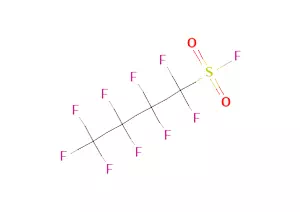All Categories



nonafluorobutanesulfonyl fluoride CAS 375-72-4, nonafluorobutanesulfonyl fluoride, CAS 375-72-4
Chemical Name:Nonafluorobutanesulfonyl FluorideOther Name:Perfluorobutylsulfonylfluoride;Perfluorobutanesulfonyl fluoride; Perfluorobutane sulfonyl fluorideCAS:375-72-4EINECS:206-792-6Type:Pharmaceutical raw materials; Organic raw materialsMolecular Formula:C4F10O2S
CAS : 375-72-4
Formula : C4F10O2S
Mol. wt. : 302.09
EINECS : 206-792-6
Chemical Name: | Nonafluorobutanesulfonyl Fluoride |
Other Name: | Perfluorobutylsulfonylfluoride; Perfluorobutanesulfonyl fluoride; Perfluorobutane sulfonyl fluoride |
CAS: | 375-72-4 |
EINECS: | 206-792-6 |
Type: | Pharmaceutical raw materials; Organic raw materials |
Molecular Formula: | C4F10O2S |
Molecular Weight: | 302.09 |

Perfluorobutane sulfonyl fluoride (NFF) is a colorless and highly volatile liquid with unique chemical properties. It is not miscible with water but can dissolve in common organic solvents, which makes it have broad application potential in the field of organic synthesis. It is particularly worth mentioning that palladium plays a crucial catalytic role in the cross-coupling reaction of sulfonates, and perfluorobutane sulfonyl fluoride, as an efficient perfluoroalkyl sulfonating agent, has demonstrated outstanding performance in this process.
Compared with the traditional trifluoromethyl sulfonate anhydride, perfluorobutane sulfonyl fluoride has significant advantages such as lower cost and higher stability. Its fluoride leaving group can be easily replaced by nucleophiles such as amines, and this characteristic provides convenient conditions for the synthesis of various fluorine-containing compounds. For instance, in reactions with phenolic salts or enols, it can respectively generate important intermediates such as sulfonamides, aryl groups and alkenyl non-fluorosulfonic acids, thereby further expanding its application scope in organic synthesis.
As a perfluorinated compound that is liquid at room temperature, perfluorobutyl sulfonyl fluoride (PBSF) not only possesses the aforementioned advantages but also attracts much attention due to its rapid reaction speed. Compared with the reaction processes of other deoxyfluorination reagents that may take several hours or even days to complete, perfluorobutyl sulfonyl fluoride can rapidly achieve the formation of the target product in just a few seconds. This highly efficient reaction property has greatly enhanced production efficiency and reduced energy consumption costs, making this substance one of the indispensable choices in many industrial fields.
Specifically, perfluorobutyl sulfonyl fluoride is mainly used in the following aspects:
Synthetic fluorocarbon surfactants: Improve the surface properties of materials by introducing perfluorinated segments;
Preparation of fluorinated pesticides: Enhancing the stability and biological activity of pesticide molecules;
Production of dyes: Enhance the dyeing effect while reducing the risk of environmental pollution;
As a dispersant for polycarbonate processing: helps improve the fluidity and uniformity of plastics during the processing.
In conclusion, perfluorobutyl sulfonyl fluoride, with its unique physicochemical properties and highly efficient reactivity, is playing an increasingly important role in modern chemical industry.
Melting point | -110°C |
Boiling point | 64 °C (lit.) |
density | 1.682 g/mL at 25 °C (lit.) |
refractive index | n20/D 1.3(lit.) |
Fp | 65-66°C |
storage temp. | Keep in dark place,Sealed in dry,Store in freezer, under -20°C |
form | Liquid |
color | Colorless to yellow |
Specific Gravity | 1.682 |
Water Solubility | Hydrolyses in water. |
Sensitive | Moisture Sensitive |

Non-fluorobutane sulfonyl fluoride, as a key chemical intermediate, plays a crucial role in multiple industrial fields. It is not only an important raw material for synthesizing fluorocarbon surfactants, but also these surfactants are widely used in multiple fields such as textiles, coatings, and cleaning products due to their unique chemical properties, such as low surface tension, high stability, and excellent wettability. Meanwhile, in the field of pesticides, non-fluorobutane sulfonyl fluoride is also a key component in the synthesis of various highly effective, low-toxicity and environmentally friendly fluorinated pesticides, which are of great significance for increasing crop yields and controlling pests and diseases. In addition, it is also used in the synthesis of dyes, making the dyes have better color vividness and durability. And as a dispersant for polycarbonate treatment, it effectively enhances the performance and application scope of polycarbonate materials.
In the field of medicine, non-fluorobutane sulfonyl fluoride also demonstrates its unique value. As an antibacterial enhancer, when used in combination with sulfonamide drugs, it can significantly enhance the antibacterial effect, providing a more effective means for the treatment of various bacterial infections. In addition, it can also be used for the treatment of coccidiosis infections and digestive tract microbial infections in poultry. By regulating the balance of intestinal flora, it promotes the healthy growth of animals.
It is particularly worth mentioning that non-fluorobutane sulfonyl fluoride has shown great potential in the synthesis of fluorine-containing surfactants. Through specific chemical reactions, it can synthesize a series of unique fluorine-containing surfactants. These surfactants not only have excellent surface activity but also possess good thermal stability, chemical stability and biocompatibility. Among them, its potassium salt - potassium perfluorobutane sulfonate - is an outstanding anionic surfactant and is widely used in multiple fields due to its excellent performance. Particularly prominent is that potassium perfluorobutane sulfonate is also one of the most effective flame retardants for polycarbonate, which can significantly enhance the flame retardant performance of polycarbonate materials, thereby broadening its application prospects in high-end fields such as aerospace and electronic appliances.
In addition, in the field of organic synthesis, non-fluorobutane sulfonyl fluoride also plays an indispensable role. For instance, the synthesis of phenylacetylene is achieved by using nonafluorobutanesulfonyl fluoride (NFF) through the domino method starting from O (trimethylsilyl) phenol. This synthetic method is not only highly efficient and environmentally friendly, but also capable of precisely controlling the reaction process and product purity, providing a high-quality raw material guarantee for subsequent scientific research and applications.
* Prompt reply and 24 hours online, professional team to provide best price and high quality product.
* Sample testing support.
* Every batch of products will be tested to ensureits quality.
*The packing also can be according the customers` requirment.
*Any inquiries will be replied within 24 hours.
*we provide Commerical Invoice, Packing List, Bill of loading, COA , Health certificate and Origin certificate. If your markets have any special requirements, let us know.